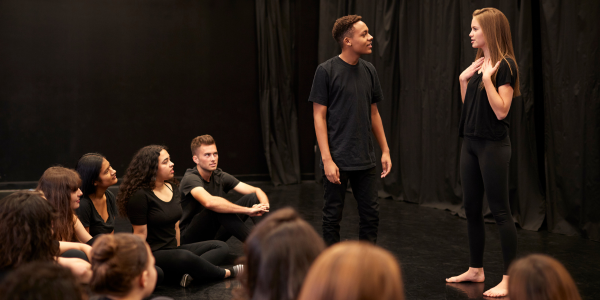26 February 2024
5 fun drama games for your middle schoolers!
Help your students develop focus with ‘Look Down, Look Up’
We know that keeping middle schoolers engaged and motivated can be challenging. This is a fun and energizing game to help your class increase their focus, concentration, and awareness.
How to play:
- Have your students stand in a circle facing each other.
- When you say ‘look down’, all students bow their heads and look down.
- When you say ‘look up’, all students must lift their heads and look directly at another student – no looking at the floor or over anyone’s head.
- If two students make eye contact, both students must ‘scream’ and have a quick, dramatic death where they fall to the ground. They then stay sitting while the game finishes. You can make the circle smaller as students are removed from the game.
- Repeat look down, look up until only two students remain – these are the winners!
Teach Improv skills with ‘Do You Remember’?
Teach your students the all-important improvisation rule of ‘yes, and’ with this game of blocking, which allows them to see the different impacts of saying ‘yes’ or ‘no’.
How to play:
- In pairs, have students start an incredibly boring scene of ‘blocking’. They should ask each other questions beginning with ‘Do you remember…’ but whatever one student asks, the other replies ‘no’. For example, ‘Do you remember when we ate that pie?’ ‘No.’
- Continue with the blocking for a minute or so, until one student chooses to say ‘yes’ to a question, kicking off the ‘yes, and-ing’ section of the game.
- Once the ‘yes’ has been said, the two students ‘yes, and’ each other, adding more and more elements to the story, continually raising the energy until one of them ends the scene saying ‘That was really fun’.
- They can then resume the boring ‘blocking’ element of the game, and continue switching between the two.
Each of the two elements can be played once or multiple times, and you can also experiment by swapping pairs around or trying the game with more than two players.
Increase concentration with ‘HA’!
The goal of this energetic warm-up game is to increase concentration, dial up the energy level in the room, and develop eye contact.
How to play:
- Get your class into a circle with plenty of space between them.
- The game begins when the first person passes a 'HA!' by raising their arms above their head with their hands clasped, locking eyes with someone across the circle, and shouting 'HA!', while bringing their arms down to point at the person.
- The person they made eye contact with should receive the ‘HA!’ by doing the same in reverse. Begin by doing this as fast as possible (in a consistent rhythm).
Want to add an extra difficulty level? Ask the people on either side of someone who has just received the 'HA!' to raise their arms above their head with their hands together before bringing them down towards them, shouting 'HA!' at the same time. This shouldn't interrupt anyone else's calls, but be an extra beat between the sending and receiving of a 'HA!'.
You can decide if you want to introduce some healthy competition by asking people to sit out if they break the rhythm, fail to make clear eye contact or hesitate during the game.
Energize your students with ‘Splat’!
This game is a fantastic warm-up activity to get energy levels up. It’ll also get students thinking quickly and increase their concentration!
How to play:
- Form a circle with one player in the middle. This person is the ‘Splatter’.
- The Splatter randomly points to someone in the circle and yells ‘Splat!’
- The player who the Splatter pointed at must instantly duck down to avoid the ‘Splat!’, while the two players on either side of the player who ducked must turn and point to each other and yell ‘Splat!’
- The slowest player to splat the other must sit down, and then the player who ducked can stand again.
- The game continues until you have a winner, who will then swap with the current Splatter to become the new one.
You can vary the game by;
- Having the person who loses at step 3 swap with the middle Splatter for a constant revolving game.
- Have new words for ‘Splat!’ each round to make things more tricky and test memory.
- Have the person who loses at step 3 perform a task in order to stay in the circle.
Boost creativity with ‘Taxi’
This is a fun improvisation game to create a playful and imaginative environment in your classroom. It's also great for building ensemble skills!
Materials: Four chairs arranged in the shape of a car, two in the front and two in the back. Assign one of the two front chairs as the "driver's seat.
How to play:
- Split your class into two groups, with one group lining up down the side of the room. The first four players in the line should each take a seat in the ‘taxi’, while the other half of the class sit down in front of the chairs – this is your audience.
- The student in the driver’s seat starts the game with a single sentence that establishes the scene. Encourage your students to use their creativity here – is the group in a car, or is it actually a spaceship? Are they driving to school in the morning or have we caught them in the middle of a police chase? The possibilities are endless, and the more ridiculous scenarios often make for more fun.
- Once the driver has started the game, the rest of the group should immediately jump on board with the scene the driver has established – this is a great way to introduce and practice the “yes, and…” rule.
- Allow the scene to run for a minute or so, before shouting ‘switch!’. At this point, one of the students in the back of the car should stand up and move to the back of the line down the side of the room, while the other three students move to the next seat in the car, leaving the driver’s seat free for the student waiting at the front of the line.
- Continue playing until every student has had a turn in the driver’s seat, then switch the two groups of students so they all get a chance to both play and act as audience.
With Digital Theatre+, you can access a treasure trove of drama games and practical activities that are not only a riot but also sneakily teach some seriously cool skills. So buckle up and get ready for some drama game fun that'll have your students begging for more!
Teaching High School? Don’t miss the best drama games to play with your high school students!
If you’d like access to hundreds of high quality productions and thousands of resources to engage your students, and are not yet a customer of Digital Theatre+, please get in touch with a member of our team today. If you already have a subscription, visit the Shakespeare Collection on the platform.
Related blogs
Top 5 2023 resources for you and your students (and they're free!)
As 2023 comes to a close, let’s take a look back at the impressive blogs and webinars that had...
Read moreAre you teaching... Feminist Theatre?
Looking for engaging new resources to teach feminist theatre? We've assembled a collection of...
Read more7 series to simplify theatre lesson planning and curriculum design
Looking for easy ways to design impactful theatre lesson plans? To save you time, Digital...
Read moreGet the latest teaching tips straight to your inbox
Explore free lesson ideas and inspiration, education news, teaching trends and much more by signing up to regular blog updates!





